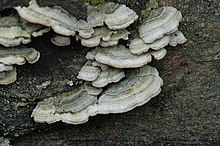
Agaricus bisporus, commonly known as the cultivated mushroom, is a basidiomycete mushroom native to grasslands in Eurasia and North America. It is cultivated in more than 70 countries and is one of the most commonly and widely consumed mushrooms in the world. It has two color states while immature – white and brown – both of which have various names, with additional names for the mature state, such as chestnut, portobello, portabellini, button and champignon de Paris.

Abies concolor, the white fir, concolor fir, or Colorado fir, is a coniferous tree in the pine family Pinaceae. This tree is native to the mountains of western North America, including the Sierra Nevada and southern Rocky Mountains, and into the isolated mountain ranges of southern Arizona, New Mexico, and Northern Mexico. It naturally occurs at elevations between 900 and 3,400 metres.
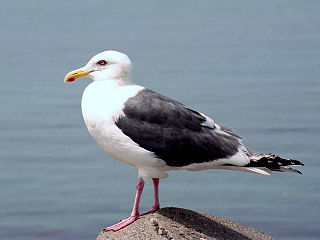
The slaty-backed gull is a large, white-headed gull that breeds on the north-eastern coast of the Palearctic, but travels widely during nonbreeding seasons. It is similar in appearance to the western gull and the glaucous-winged gull. Another alternate name is Pacific gull, though it also applies to a Southern Hemisphere species, L. pacificus.

The white-footed dunnart is a marsupial that occurs on Tasmania and mainland Australia. It occurs along the coast and in inner Gippsland and Alpine areas up to 400 metres near Narbethong. In southern New South Wales, the white-footed dunnart is known to occur at elevations at least as high as 1000 metres. The length from snout to tail tip is 14–20 cm (5.5–7.9 in) of which head and body are 7–11 cm (2.8–4.3 in) and the tail 7–9 cm (2.8–3.5 in) long. They weigh 19–27 g (0.67–0.95 oz).

The moonrat is a southeast Asian species of mammal in the family Erinaceidae. It is the only species in the genus Echinosorex. The moonrat is a fairly small, primarily carnivorous animal which, despite its name, is not closely related to rats or other rodents. The scientific name is sometimes given as Echinosorex gymnurus, but this is incorrect.

Cerrena unicolor, commonly known as the mossy maze polypore, is a species of poroid fungus in the genus Cerrena. This saprobic fungus causes white rot.
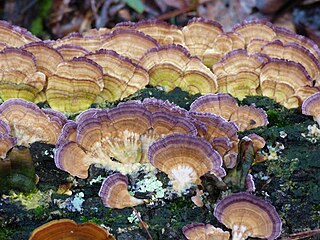
Trichaptum biforme, commonly known as the violet-pored bracket fungus, purple tooth, or violet-toothed polypore, is a species of poroid fungus in the order Hymenochaetales.

Trichaptum is a genus of poroid fungi. The genus was circumscribed by American mycologist William Alphonso Murrill in 1904. Formerly classified in the family Polyporaceae, several molecular studies have shown that the genus belongs to the order Hymenochaetales.

Skeletocutis is a genus of about 40 species of poroid fungi in the family Polyporaceae. The genus has a cosmopolitan distribution, although most species are found in the Northern Hemisphere. It causes a white rot in a diverse array of woody substrates, and the fruit bodies grow as a crust on the surface of the decaying wood. Sometimes the edges of the crust are turned outward to form rudimentary bracket-like caps.

Dendroctonus rufipennis, the spruce beetle, is a species of bark beetle native to British Columbia, Newfoundland and Labrador, Nova Scotia, Ontario, Quebec, Northern Manitoba, the Yukon, Alaska, Colorado, Wyoming, Montana, and Maine. They are known to destroy forests of spruce trees including Engelmann, White, Sitka, and Colorado blue spruce. Adults average 4 to 7 mm in length.

Amanita eliae is an inedible species of fungi in the family of Amanitaceae found in Europe. It was described by Lucien Quélet in 1872. Synonyms include A. eliae, A. godeyi, and A. cordae.

The white-legged duiker is a medium-sized antelope species from the subfamily of duikers (Cephalophinae) within the family of bovids (Bovidae). It is native to Gabon and the Republic of the Congo. It was described as subspecies of the Ogilby's duiker by Peter Grubb in 1978. After a revision of the ungulates in 2011 by Colin Groves, it is now regarded as distinct species.

Peridermium is a genus of rust fungi in the family Cronartiaceae.
Trichaptum imbricatum is a species of fungus in the family Polyporaceae. It is distinguished by its imbricate basidiocarps, white to cream hymenophores, small and regular pores, and scattered and thin-walled cystidia. It was first isolated from China.
Trichaptum perenne is a species of fungus in the order Hymenochaetales. It differs from species in its genus by its perennial and pileate habit, its large pores and dissepiments, and oblong, ellipsoid basidiospores. It was first isolated from China.
Trichaptum podocarpi is a species of fungus in the order Hymenochaetales. It differs from species in its genus by having totally resupinate basidiocarps, distinctly long cystidia, and in its habitat on Podocarpus. It was first isolated from China.

Calicium abietinum, commonly known as fir pin or black stubble, is a crustose lichen that is found growing on trees throughout much of the world.
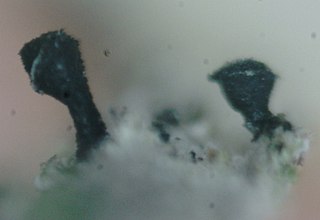
Calicium glaucellum is a crustose lichen that is found growing on trees throughout much of the world. The species is similar to Calicium abietinum.
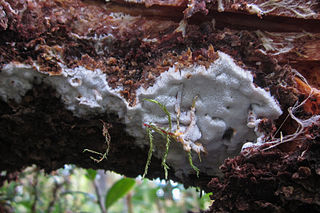
Skeletocutis kuehneri is a species of poroid crust fungus in the family Polyporaceae. It was described as new to science by Alix David in 1982. The holotype was collected in France, where it was found growing on pine. It has been recorded from Norway, Finland, and Sweden, although it is rare in the Nordic countries. The fungus is a successor species, and prefers growing on pine that has been previously degraded by Trichaptum fungi, particularly T. abietinum.
Elatobium abietinum, commonly known as the spruce aphid or green spruce aphid, is a species of aphid in the subfamily Aphidinae that feeds on spruce, and occasionally fir. It is native to Northern, Central and Eastern Europe and has spread to Western Europe, North America and elsewhere.
